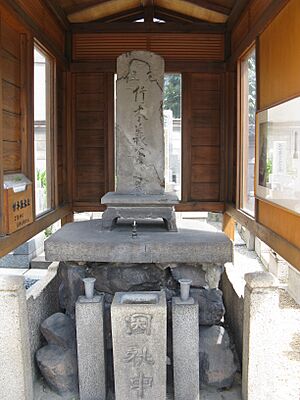Takemoto Gidayū facts for kids
Takemoto Gidayū (竹本 義太夫, 1651 – 18 October 1714) was a very important person in the history of Japan's puppet theatre. He was a jōruri chanter, which means he told stories by singing and speaking. He created a special style of narration for puppet shows that is still used today. In fact, the name "gidayū" is now used for all jōruri chanters! He worked closely with the famous writer Chikamatsu Monzaemon and started his own puppet theatre called the Takemoto-za.
Before he became known as Takemoto Gidayū, his name was Kiyomizu Gorōbei. He changed his name to Takemoto Gidayū no Jō in 1701.
Contents
Life and His Theatre Work
Takemoto Gidayū grew up in the Tennōji area of Osaka. He first started performing in Kyoto as a student of another chanter named Uji Kaganojō.
In 1684, Gidayū decided to leave Kyoto and go back to Osaka. There, he started his very own theatre, the Takemoto-za. Soon after, he began working with Chikamatsu, a writer he had met in Kyoto. Together, they made big changes to the traditional jōruri style. They made it into the popular form that people loved throughout the Edo period (1603-1868) and that we still see today.
Gidayū's Ideas and Writings
Gidayū's first published work was called Chihiroshū (which means "A Collection a Thousand Fathoms Deep") and came out in 1686. But his most important writing was published the next year. This work, called Jōkyō yonen Gidayū danmonoshū, included a long introduction where Gidayū shared his ideas about theatre and performing. This book became a very important guide for jōruri performers for a long time, even up to the late 1800s.
Gidayū respected the old traditions of jōruri. However, he also believed his art was new and modern. He sometimes made fun of people who cared more about old family lines and traditions than about real skill and beautiful performances.
How Gidayū Structured Plays
Gidayū also created a special way to structure jōruri plays. He based his ideas on the structure used for Noh theatre, which was described by Zeami Motokiyo.
According to Gidayū's plan, a play has five acts and is performed over a whole day:
- The first act is a happy beginning.
- The second act usually has some kind of conflict or problem.
- The third act is the most exciting part, often with sad or emotional moments.
- The fourth act is a lighter scene, often a michiyuki (a travel scene).
- The fifth act is a quick and happy ending.
The Role of a Gidayū Chanter
In the gidayū style, one chanter tells the whole story of the play by themselves. They also speak (or sing) the lines for every single character! The chanter's style changes a lot, moving between speaking and singing. They follow special notes written in their script.
Chanters usually don't perform an entire play alone. They often switch with another chanter after one, two, or three acts. It's very rare for two chanters to perform at the same time. All these traditions and ways of performing were either started or greatly changed by Takemoto Gidayū.
His son, Takemoto Seidayū, took over as the director of the Takemoto-za theatre after him. He continued to use the style and forms that Gidayū had created.


